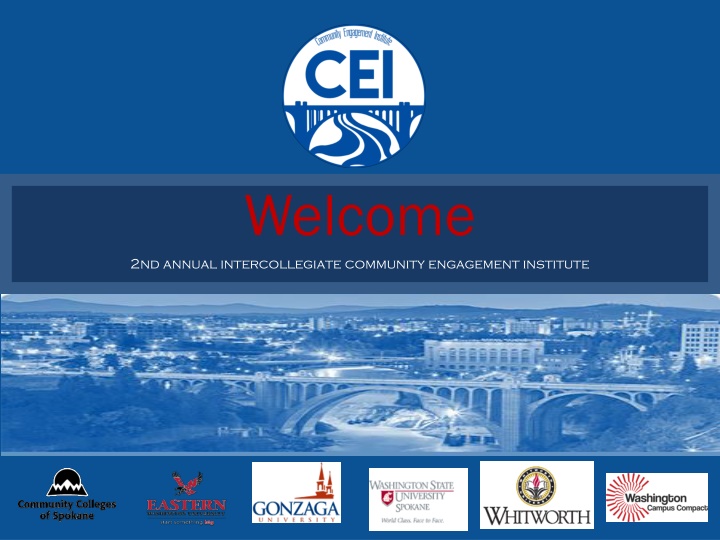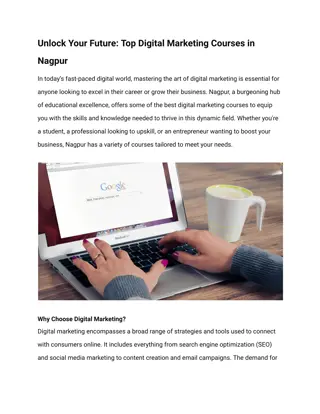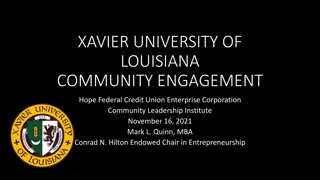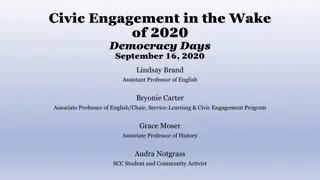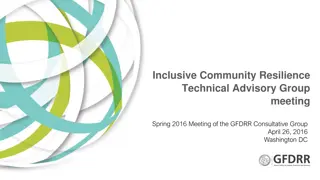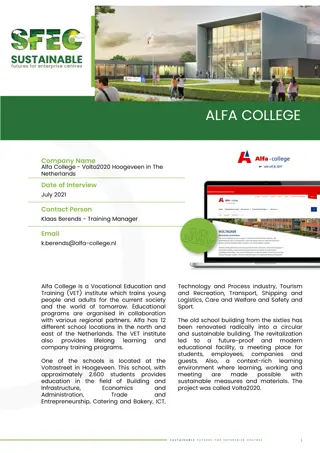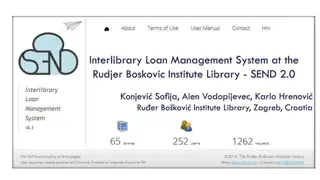Community Engagement Institute
Unpack the evolution and impact of engaged scholarship in higher education. Explore the intersections between universities and communities through the lens of community-engaged scholarship. Delve into the definitions, challenges, and applications of CES as a field of inquiry. Discover how engaged scholarship has punctuated the landscape of academic work and institutional barriers, shaping the narrative of collaborative learning and research.
Download Presentation

Please find below an Image/Link to download the presentation.
The content on the website is provided AS IS for your information and personal use only. It may not be sold, licensed, or shared on other websites without obtaining consent from the author.If you encounter any issues during the download, it is possible that the publisher has removed the file from their server.
You are allowed to download the files provided on this website for personal or commercial use, subject to the condition that they are used lawfully. All files are the property of their respective owners.
The content on the website is provided AS IS for your information and personal use only. It may not be sold, licensed, or shared on other websites without obtaining consent from the author.
E N D
Presentation Transcript
Welcome 2nd annual intercollegiate community engagement institute
Community Engaged Scholarship The Basics Ross Brooke Watts, Director of the Dornsife Center for Community Engagement, Whitworth University
To place CES in the context of a larger body of literature examining how universities and communities interact To review some of the better known definitions of CES To appreciate the terminological messiness of CES To apply the terms of CES to your own work in the community To identify elements of CES (and obstacles to them) in faculty stories Session goals
Lorilee Sandmann and Punctuated Equilibrium CES AS A FIELD OF INQUIRY
What does evolutionary biology have to do with my academic work in the community? Eldredge and Gould (1972) explained the radical transformations in speciation following long periods of continuity Sandmann (2008) applies term to scholarly writing on engagement
Punctuations in writing on engagement 1. Defining engagement (1990s) Follow up to Boyer (1990) Effort to differentiate engagement from outreach or public service Bidirectional interaction Integration of teaching and research with a public mission 2. Deploying engagement (2000s) Applying engagement through instruction and/or research Descriptive works such as case studies and benefits analyses Reciprocity present Knowledge generation is public participation lacking
Punctuations, continued 3. Engagement as scholarship (2000s present) Writing on engagement work as scholarship related to institutional context Integration, research and application Writing that articulates qualitative features of scholarship that apply to engagement work Improving quality of scholarship 4. Engagement institutionalized (2000 present) Writing that examine institutional barriers to a new scholarship
Our focus is Punctuation #3 So, although there are multifaceted practices, engaged scholarship (as engagement as scholarship has come to be called) has evolved as a distinct dimension of the engagement movement and is evolving a distinctive scholarly expression and architecture. It builds on, and yet differs from, traditional scholarship, which is perceived to be disciplinary, homogenous, expert-led, supply driven, hierarchical, peer-reviewed and almost exclusively university-based knowledge generation. Engaged knowledge generation, in contrast, is applied, problem-centered, demand driven, entrepreneurial, network-embedded, and so on. (Sandmann, 2008)
Ernest Lynton, 1995 AAHE publication Charles Glassick, et al, 1997 Carnegie Foundation for the Advancement of Teaching National Review Board for the Scholarship of Engagement, 2005 Jeffrey Howard, 2007 Campus Compact publication Useful articulations from the 90s and 00s
Lynton, 1995 Making the Case for Professional Service Effort to distinguish CES from Institutional citizenship (committee work, etc.) Disciplinary citizenship (peer-review, journal work, etc.) Civic contributions (public office, philanthropy, volunteering) Insistence on professional expertise [in course of engagement] sufficiently distinguishes CES (p. 18)
Lyntons Features of CES 1. The scholar learns something (discovery/originality/absence of SOP) 2. Knowledge advances base of discipline 3. Scholarly activity is responsive and adaptive 4. Reasoned choice of goals reflecting agreement with client 5. Methods chosen appropriate to scope of work and context
More Lynton (1995) 6. Scholar undertakes reflection (observing, assessing, making adjustments) 7. Reflection generates outcomes (results, inferences, new insights that can be generalized) 8. Outcomes can be shared with colleagues formally or informally (community)
Charles Glassick et al. (1997) 6 standards of scholarly work 1. Does scholar have clear goals? 2. Is scholar adequately prepared for the project? (Lit review, expertise, resources) 3. Has the scholar chosen appropriate methods? (adaptive to changes?) 4. Does the scholar achieve goals? (significant?) 5. Is there effective presentation of work? 6. Is there reflective critique? (self-evaluation, breadth of evidence?)
National Review Board on Sch. f Engagement The Hegelian synthesis Goals/Questions Does the scholar state the basic purpose of the work and its value for public good? Is there an "academic fit" with the scholar's role, departmental and university mission? Does the scholar define objectives that are realistic and achievable? Does the scholar identify intellectual and significant questions in the discipline and in the community? Context of theory, literature, "best practices" Does the scholar show an understanding of relevant existing scholarship? Does the scholar bring the necessary skills to the collaboration? Does the scholar make significant contributions to the work? Is the work intellectually compelling? Methods Does the scholar use methods appropriate to the goals, questions and context of the work? Does the scholar describe rationale for election of methods in relation to context and issue? Does the scholar apply effectively the methods selected? Does the scholar modify procedures in response to changing circumstances?
More National Review Board Results Does the scholar achieve the goals? Does the scholar's work add consequentially to the discipline and to the community? Does the scholar's work open additional areas for further exploration and collaboration? Does the scholar's work achieve impact or change? Are those outcomes evaluated and by whom? Does the scholar's work make a contribution consistent with the purpose and target of the work over a period of time? Communication/Dissemination Does the scholar use a suitable styles and effective organization to present the work? Does the scholar communicate/disseminate to appropriate academic and public audiences consistent with the mission of the institution? Does the scholar use appropriate forums for communicating work to the intended audience? Does the scholar present information with clarity and integrity? Reflective Critique Does the scholar critically evaluate the work? What are the sources of evidence informing the critique? Does the scholar bring an appropriate breadth of evidence to the critique? In what way has the community perspective informed the critique? Does the scholar use evaluation to learn from the work and to direct future work? Is the scholar involved in a local, state and national dialogue related to the work?
Howard, 2007 An effort to simply the explanation of CES An effort to distinguish CES from other types of service What purposes, products and processes serve as evidence of scholarship?
Apply the criteria of Lynton, Glassick, the National Review Board or of Howard to your own work in the community AN EXERCISE
Dr. Jane Pimentel EWU, Communication Disorders Dr. Patricia Lucero Chantrill EWU Communication Dr. Jason Wollschleger Whitworth, Sociology INPUT FROM A FACULTY PANEL
